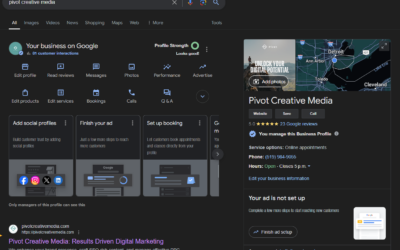Search Engine Optimization, or SEO, is a critical part of a successful online presence. We understand it as the suite of strategies and techniques aimed at improving a website’s visibility in search engine results. Given the complexity of search algorithms like those used by Google, it’s vital to recognize that SEO is not a monolithic task but rather a spectrum of various practices, each suited for different aspects of digital marketing. Every business, regardless of size or industry, can leverage SEO to increase the quantity and quality of traffic to their website through organic search engine results.
Our approach to SEO is multifaceted, involving both creative and technical elements. On-page SEO, for instance, focuses on optimizing the content on a website, ensuring that it not only resonates with your audience but also adheres to search engine guidelines for better rankings. Technical SEO, on the other hand, deals with the non-content elements, such as site speed and mobile-friendliness – factors that affect a site’s readability and user experience. Beyond the website itself, off-page SEO techniques such as link-building elevate a site’s authority and credibility, which are vital for ranking higher. As search patterns evolve and diversify, so too does our strategy, adapting to encompass local and international SEO that targets geographic-specific markets and mobile SEO to cater to the increasing number of users on mobile devices.
Key Takeaways
- SEO is an essential set of strategies for enhancing website visibility in search engine results.
- Effective SEO integrates on-page content optimization with technical improvements and off-page tactics.
- Adapting SEO strategies to evolving online trends and user behaviors is essential for maintaining relevance.
Understanding SEO Fundamentals
In our approach to SEO, it’s critical to comprehend its various components, which include on-page SEO, off-page SEO, and technical SEO.
On-page SEO focuses on content and how we optimize it for both search engines and users. This involves the strategic use of keywords, creating quality content, and ensuring proper meta tags are in place.
- Keywords: We integrate relevant terms that users are searching for.
- Content: We develop informative and engaging content that answers user’s queries.
- Meta Tags: We craft descriptive titles and meta descriptions that are Click-Through Rate (CTR) optimized.
Off-page SEO pertains to actions taken outside of our own website to impact our rankings within search engine results pages (SERPs). Central to off-page SEO is link building, as the quantity and quality of backlinks are key indicators of a website’s reputation.
- Backlinks: We aim to gain high-quality links from authoritative sites.
- Social Signals: We boost our content’s visibility through social media shares and engagement.
Technical SEO, on the other hand, ensures that our website is structured in a way that search engines can understand and index our content efficiently. This includes optimizing our site’s speed, mobile-friendliness, and site architecture.
- Site Speed: We optimize loading times for a better user experience.
- Mobile-friendliness: We ensure our site is responsive on all devices.
- Site Architecture: We structure our website logically so that search engines can crawl it effectively.
Each type of SEO serves an integral role in our broader strategy, reinforcing the foundation that helps us improve online visibility and rankings. By addressing all three, we set our website up for success, making it findable, accessible, and authoritative.
On-Page SEO Techniques
On-page SEO is pivotal to enhancing our webpage’s visibility to search engines. By fine-tuning elements such as keywords and meta descriptions directly within our website, we can significantly influence our content’s performance.
Keyword Optimization
In keyword optimization, we prioritize the use of relevant and strategically-selected keywords within our content. Our process begins with thorough keyword research to identify precise words and phrases our target audience uses. We incorporate these findings naturally into our:
- Page titles
- Headings and subheadings
- Main content
- Image alt attributes
- URLs
It is crucial to ensure that our keywords strike a balance between search volume and competitiveness, staying as relevant to our topic as possible without oversaturating the text.
High-Quality Content Creation
High-quality content creation hinges on providing value to our readers. Our content has to be original, informative, and engaging, which guides users and search engines to see the relevance and authority of our pages. Key elements include:
- Originality: We avoid duplicate content.
- Usefulness & Relevance: Content should be informative and related to the search intent.
- Multimedia elements: Including relevant images and videos, optimized with the right keywords in file names and alt text, will enhance user experience and content appeal.
Optimizing Page Titles and Meta Descriptions
Finally, page titles and meta descriptions are critical pieces within on-page SEO. These elements provide the first impression of our page on search engine results pages (SERPs) and influence whether users click through to our site.
- Page Titles: We create unique and precise titles that include main keywords and accurately reflect the page content.
- Meta Descriptions: We write compelling descriptions under 160 characters that also incorporate target keywords, providing a brief summary of the page and encouraging click-throughs.
By employing these in-depth techniques, we ensure our on-page SEO practices achieve their intended outcome – improving the relevance and authority of our website, and therefore its ranking in search results.
Technical Aspects of SEO
In ensuring our websites rank effectively in search engine results, we must focus on optimizing the technical aspects of our websites. These elements are crucial for both improving user experience and making our sites more understandable and accessible to search engines.
Site Architecture and Navigation
A well-structured site architecture and clear navigation enable search engines to crawl our site more efficiently. Site architecture should be organized in a logical hierarchy, with a URL structure that reflects our content categories. Key elements include:
- Optimized URL structure: Short, descriptive URLs with relevant keywords.
- Logical site hierarchy: Intuitive categorization that mirrors user expectations and search engine understanding.
- Internal linking: Strategically placed links that guide users and bots through our site’s pages.
Creating an XML sitemap and a properly configured robots.txt file guides search engine bots through the pages we want indexed, facilitating better site coverage.
Improving Site Speed
Page speed is a direct ranking factor, and it is also a part of Core Web Vitals, which are indicators of the quality of user experience. To enhance page speed, we focus on:
- Compressing images and utilizing caching.
- Minimizing the use of blocking JavaScript and CSS.
- Employing a content delivery network (CDN) to reduce load times globally.
Mobile Optimization
With the majority of searches occurring on mobile devices, it’s essential for our SEO strategy to adopt Mobile SEO practices. To ensure our websites perform well on mobile we ensure:
- Responsive design: Our site’s design adjusts seamlessly to fit the user’s screen, enhancing usability.
- Mobile-first indexing: Given that search engines predominantly use the mobile version of content for indexing and ranking, our websites must prioritize mobile UX.
Utilizing Structured Data
Structured data helps search engines understand the content on our pages and provide more informative results to users. We implement structured data in the form of:
- Schema markup to annotate elements on our web pages.
- Using JSON-LD format recommended by Google for linking a page’s data with its context.
By carefully applying these technical SEO practices, we contribute significantly to our website’s discoverability, usability, and relevance, which are essential for search engine visibility and user satisfaction.
Off-Page SEO Strategies
In off-page SEO, we focus on strategies outside our website that improve our site’s search rankings. These tactics involve gaining backlinks, fostering social media presence, and amplifying our brand resonance.
Link Building and Backlinks
Link Building is a cornerstone of off-page SEO. We prioritize earning natural links from authoritative websites, as these are indicators of our site’s credibility to search engines. A robust backlink profile can significantly impact our search engine rankings.
- Guest Blogging: By contributing content to other websites, we can include backlinks to our own site.
- Broken Link Building: We identify broken links on external sites and suggest our own content as a replacement.
- Skyscraper Technique: We create content that improves upon existing popular content with the aim of replacing their backlinks with ours.
Social Media Engagement
Our presence on social media platforms is vital for extending our content’s reach and generating indirect backlinks. By engaging with our audience, we create opportunities for our content to be shared, which can lead to increased website traffic and natural link accumulation.
- Regular Posting: Keeping our social media profiles active with regular posts contributes to our brand’s visibility.
- Community Interaction: Responding to comments and participating in conversations builds relationships with our audience.
Brand Mentions and Outreach
We enhance off-page SEO through strategic outreach and fostering brand mentions across different channels.
- Influencer Partnerships: Collaborating with influencers can amplify our brand’s reach and authority.
- Reviews and Testimonials: Encouraging satisfied customers to leave positive reviews bolsters our online reputation.
- Mentions in Forums and Discussion Groups: Participating in relevant conversations can yield natural mentions and bolster our expertise.
By implementing these off-page SEO strategies, we work towards improving our site’s authority, visibility, and search engine perception.
Local and International SEO
In this section, we’ll hone in on the best practices for optimizing businesses for both local and international audiences. We’ll break down the importance and methodologies behind Local and International SEO, ensuring you can target customers in specific locales as well as on a global scale.
Optimizing for Local Search
To effectively capture local markets, we focus on optimizing our Google Business Profile, which boosts visibility on Google Maps and local search results. It’s essential to ensure that our business information is accurate, up-to-date, and complete. Utilizing local keywords within our content, tags, and descriptions helps us to appear in searches that are geographically relevant. Local SEO also involves cultivating reviews and engaging with our community to enhance local trust metrics.
Global SEO Strategies
When it comes to International SEO, we delve into more complex approaches. Our strategies here revolve around understanding and targeting various international markets uniquely. We utilize hreflang tags to direct users to the correctly localized version of our website. Implementing country-specific domain strategies supports our audience’s needs based on their region. It’s crucial to customize content such that it resonates within different languages and cultural contexts, ensuring we provide value across the globe.
SEO for Different Business Models
When tailoring SEO strategies, we recognize that different business models have unique requirements. Here, we’ll explore the core SEO practices for e-commerce and enterprise-scale businesses to capture organic traffic effectively.
Ecommerce SEO Essentials
For e-commerce SEO, we focus on optimizing product pages and ensuring our site structure aids in discoverability. Here’s a brief rundown:
- Product Page Optimization:
- Title tags with primary keywords
- High-quality images with descriptive alt text
- Engaging, keyword-rich product descriptions
- Site Structure:
- Logical hierarchy for categories and subcategories
- Simple, clean URLs that reflect the site’s organization
- Breadcrumbs for easy navigation and indexing
- User Experience (UX):
- Mobile responsiveness
- Fast loading times
- Clear call-to-action (CTA) buttons
Creating comprehensive content around products, such as guides or blogs, contributes to building a campaign that supports long-tail keyword targeting and user engagement.
Enterprise-Level SEO Practices
Enterprise SEO involves managing a large-scale website and often numerous campaigns. We employ practices that maintain coherence and efficiency:
- Technical SEO:
- Scalable site architecture
- Efficient crawling and indexing through a robust XML sitemap and robots.txt file
- Monitoring for crawl errors and duplicate content
- Content Strategy:
- Creation of authoritative content for thought leadership
- Leveraging data for content personalization and segmentation
- Link Building:
- Focusing on earning high-quality, authoritative backlinks
- Developing relationships with industry leaders and platforms
In both our enterprise SEO and e-commerce campaigns, keeping a sharp eye on analytics helps us refine strategies to boost organic traffic and align with our business objectives.
SEO Tactics and Their Impact
In the evolving landscape of search engines, SEO tactics play a critical role in influencing website rankings. From ethical approaches to manipulative strategies, our understanding of these tactics can significantly affect our online success.
White Hat vs Black Hat SEO
White Hat SEO refers to the collection of SEO techniques that align with search engine guidelines. These tactics are designed for a human audience rather than focusing solely on search engines and typically provide long-term benefits. Some of the core strategies include:
- High-Quality Content Creation: Producing valuable and relevant content for users.
- Efficient Keyword Usage: Strategically placing well-researched keywords without overuse.
- Link Building: Earning links from reputable sources naturally over time.
In contrast, Black Hat SEO involves practices that violate search engine guidelines. The intent is often to create quick, short-term gains in search rankings but these gains come with a high risk of penalties and de-indexing. Notable black hat SEO tactics include:
- Cloaking: Showing different content to search engine crawlers than to users.
- Keyword Stuffing: Overloading content with irrelevant keywords.
- Buying Links: Paying for backlinks to manipulate PageRank.
We also recognize Gray Hat SEO, which is more ambiguous and can involve fluctuating between ethical and risky practices. This might include tactics that border on the edge of search engine guidelines but haven’t been explicitly recognized as noncompliant.
Dealing with Negative SEO
Negative SEO is a set of activities aimed at decreasing a competitor’s search engine rankings. These actions can potentially harm the online reputation and SEO efforts of a business. Some common negative SEO strategies include:
- Unnatural Links: Creating spammy or toxic backlinks to a site.
- Negative Reviews: Posting fake negative reviews about a company or product.
- Hacking Websites: Unauthorized access to a site to modify content or create redirects.
To protect against negative SEO, it’s crucial to:
- Monitor Backlinks: Regularly check for suspicious new links and use disavow tools if necessary.
- Enhance Security Measures: Keep software updated and secure access points to prevent unauthorized site changes.
- Track Online Reputation: Watch for unjustified negative reviews and respond appropriately.
Understanding the nuances of various SEO tactics and their potential impact can help us navigate the complexity of search engine optimization and adopt strategies that best serve our long-term goals.
Evolving Trends in SEO
As we navigate through the dynamic landscape of SEO, two transformative trends stand out: the integration of voice and visual searches and the sophisticated application of AI and machine learning. These advancements are redefining how users interact with content and how we optimize for organic search results, each enhancing the user experience in unique ways.
Voice and Visual Search
Voice search SEO is becoming increasingly pivotal as more users turn to virtual assistants for their search queries. Here are the key factors we need to focus on to optimize for voice search:
- Natural Language Processing (NLP) allows us to align content with conversational queries.
- Local SEO remains crucial, with users often seeking location-based answers through voice commands.
Visual search, on the other hand, leverages image SEO to accommodate users who search using images instead of text. When optimizing for visual searches, consider these points:
- High-quality, relevant images are a priority, complemented by descriptive ALT tags.
- Loading times impact both user experience (UX) and SEO, so image compression and proper formatting are vital.
AI and Machine Learning in SEO
AI-driven SEO revolutionizes how we understand and serve content to users. Here are the specific implementations of AI that are shaping SEO:
- Content Marketing: AI tools help us create optimized content faster.
- Video SEO: Machine learning is vital in understanding video content, which can be leveraged for platforms like YouTube.
- Semantic SEO: AI enables us to optimize for intent rather than just keywords, leading to a more nuanced understanding of queries.
Programmatic SEO applies AI in automating large-scale SEO tasks, allowing for advanced SEO strategies to be executed with precision. Moreover, as search engines evolve, user-friendly and semantic elements will become even more intertwined with AI to enhance the organic search experience.
Frequently Asked Questions
In this section, we explore some of the most common queries related to the various facets of search engine optimization.
What are the main categories of SEO techniques?
We generally categorize SEO techniques into three primary areas: on-page SEO, which focuses on content and page optimization; off-page SEO, which involves activities conducted outside of our website to improve its reputation and authority; and technical SEO, which optimizes the infrastructure of our website for search engine crawling and indexing.
How does on-page SEO differ from off-page SEO?
On-page SEO involves optimizing elements directly on our website, such as content, HTML tags, and images, to improve search relevance and user experience. Off-page SEO, on the other hand, is about building our site’s reputation through backlinks, social media presence, and other external signals that contribute to our site’s authority.
Can you explain technical SEO and its importance?
Technical SEO refers to optimizing the technical aspects of our website so that search engines can crawl and index it efficiently. This includes improving site speed, mobile-friendliness, and secure connections (HTTPS). Ensuring our site has a sound technical foundation is essential for it to be considered favorably by search engines.
What are some effective SEO strategies for content optimization?
Effective content optimization strategies include conducting thorough keyword research to understand what our audience is searching for, creating high-quality and engaging content that answers those queries, and using structured data to help search engines understand our content contextually.
How do local SEO practices differ from traditional SEO?
Local SEO targets optimizing our site to appear in search results for a local audience. It involves tasks like optimizing for local keywords, claiming our business listings on platforms like Google My Business, and managing local citations and reviews to establish a strong presence within the community.
What are the latest trends in SEO practices for digital marketing?
Current trends in SEO include the increased importance of voice search optimization, focusing on user experience (UX) factors such as Core Web Vitals, the role of artificial intelligence in shaping search algorithms, and the need for a comprehensive mobile strategy due to the predominance of mobile search queries.




